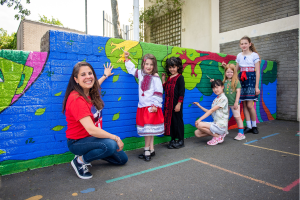World Environment Day is celebrated on 5 June, and the day is a great opportunity to talk about and celebrate the planet with our dear ones, including our kids.
The climate crisis is a huge hot topic but despite the increasing stress it causes young people and adults, parents often don’t do enough to teach their kids about it. Sustainability expert and father of two (3 and 7 years old), Mark Hall, co-founder of BusinessWaste.co.uk shares his top strategies for introducing to kids the concept of climate change and the importance of protecting the planet.
Mark says: “We teach our kids about all the animal sounds and buy them animal-themed toys, but when it comes to the more hard-hitting topics, we tend to avoid talking about them to protect them.
However, teaching kids from an early age about the importance of protecting the planet has never been more important. Simply try to approach the topic in both an informative and reassuring way to help them understand the challenges without feeling overwhelmed but creating a desire for them to help.”
- Start with the basics
First, make sure you understand the fundamentals of climate change so you can explain it to the kids in an easy and age-appropriate language. This will also prepare you for any questions they may have. From temperatures rising to sea levels and how all these affect habitat loss – make sure you tell everything in a logical way that makes sense to them. Use relatable examples – for example comparing the greenhouse effect to a blanket that warms the Earth can help clarify these abstract concepts.
- Use Visuals and Stories
Children connect well with visual aids and storytelling. Make use of books and interactive online resources that show the science and effects of climate change in engaging ways. For instance, showing before-and-after images of glaciers and wildlife affected by habitat changes can help them understand better. Stories of young environmental activists can also inspire them and show that every little effort counts.
- Encourage Questions and Express Feelings
Create a safe space for children to ask questions and express their feelings about climate change. Some children feel anxious about the impacts of climate change, also known as eco-anxiety. Acknowledge their feelings and reassure them by focusing on the solutions and the things people are doing to mitigate climate change. This dialogue can empower children, making them feel part of the solution rather than helpless observers.
- Help them connect with nature
Research consistently shows that connection to nature has positive effects on well-being, and psychological and physical health. By encouraging children to spend time outside, we not only look after their health, but they’ll also learn to appreciate and protect the natural environment even more. Get them involved in activities that promote an active and thoughtful relationship with nature, such as art projects outdoors, questions about what they find beautiful and love about nature, and efforts to improve natural spaces.
- Get Involved Together
Get involved in small environmental actions with the kids to show them how you can help together practically. This can be empowering for children. Think of activities as small as teaching them how to recycle at home, plant a few trees together, or even participate in local clean-up days. This hands-on involvement helps children understand the impact of individual actions and fosters a sense of responsibility and control over their contributions to the planet’s health.





